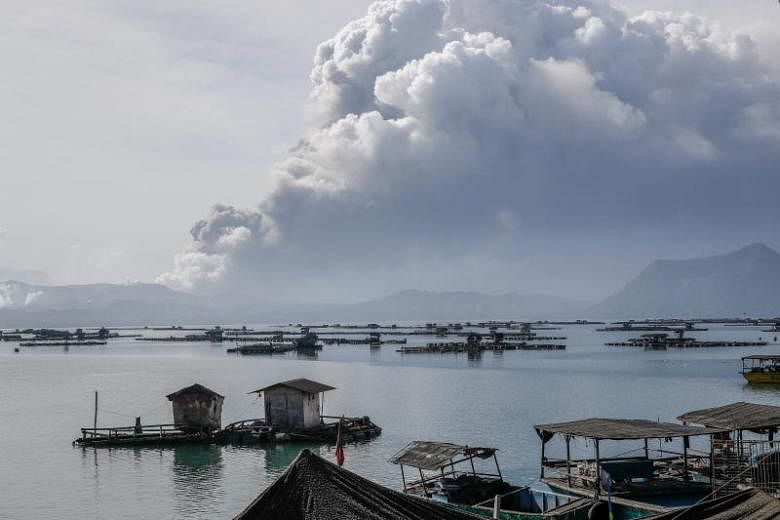SINGAPORE - A volcanic eruption south of the Philippine capital of Manila on Sunday (Jan 12) resulted in many flights cancelled or rescheduled as Manila's international airport was closed.
A massive ash cloud from the eruption drifted north across the city and on Monday, at least 37 flights between Singapore and Manila were affected, even though the Philippine authorities said that flight operations partially resumed on the same day.
The affected airlines include Singapore Airlines, Scoot, Jetstar Airways and Philippine Airlines, according to Changi Airport's website.
Here are five things to know about the Taal volcano and its latest eruption:
1. SMALL VOLCANO BUT ONE OF THE MOST DANGEROUS
The Philippines currently has 24 active volcanoes, including Taal.
It lies on the Pacific Ring of Fire, which is notorious for its active volcanoes and frequent earthquakes caused by tectonic movements that make the area especially disaster-prone.
Taal, located about 60km south of Manila on the island of Luzon, is one of the the world's smallest volcanoes - it rises just 3m above sea level and has a lake-filled opening about 20km by 15km across.
Even so, it is considered among the world's most dangerous and is the second most active volcano in the Philippines.

One eruption in 1754 lasted six months, and another in 1911 took 1,335 lives.
In the past 450 years, Taal has recorded at least 34 major and minor eruptions.
Its history of large, destructive eruptions led it to be designated as one of 16 "decade volcanoes" by the International Association of Volcanology and Chemistry of the Earth's Interior in the 1990s.
This, based on the volcano's history of eruptions and proximity to people, earmarked it for more focused research and public awareness programmes.
Taal is considered a caldera and was formed after a large volcanic eruption led it to collapse into itself about 100,000 to 500,000 years ago.
2. 'HAZARDOUS ERUPTION' YET TO HAPPEN
While no casualties and no major damage have been reported so far after the Taal volcano began erupting on Sunday, scientists warned that a more "hazardous eruption" could still happen any time.
Since the Taal volcano began spewing ash and steam on Sunday, more than 20,000 villagers in the Batangas and Cavite provinces have fled their homes. Poor visibility and transport problems have hindered this process, with officials saying some villagers needed convincing because they wanted to save their pigs and herds of cows.
Already, the ongoing eruption has triggered some 75 earthquakes and resulted in more than 500 cancelled flights.
A change in wind directions has also seen ash blowing over more areas, as the local authorities warned that these could cause respiratory problems in the very young and those with pre-existing lung conditions.
3. AIRPORT RESUMES PARTIAL OPERATIONS
Flight operations at the Ninoy Aquino International Airport partially resumed on Monday even as the authorities continued to closely monitor the situation.
The airport was shut down on Sunday when ash from Taal blew more than 100km north into Manila, reducing visibility.
Even as red-hot lava continued to gush out of Taal on Monday, the Department of Transportation, Manila International Airport Authority and the Civil Aviation Authority of the Philippines tentatively resumed the airport's operations.
The backlog from Sunday meant that planes that have been parked since Sunday night were given priority, while flight arrivals were subjected to slot availability.
An alternative airport north of Manila at Clark Freeport remains open but the authorities said they would shut it down, too, if ash fall threatens flights.
4. $67m EMERGENCY FUND
Philippine Finance Secretary Carlos Dominguez told Bloomberg that the government has set aside at least US$50 million (S$67m) in an emergency fund that could be used to support disaster relief and rebuilding efforts.
But on the ground, dust masks have sold out even as volunteers and respondents directing rescue and evacuation efforts said they were in need of masks.
Each year, natural disasters cause about US$1.2 billion in socio-economic damage to the Philippines, including the loss in manpower when employees stay home during eruptions such as Taal's.
Each year, about 20 typhoons and other major storms also lash the Philippines.
5. ERUPTION IMPACT
Besides ash clouds disrupting air travel, volcanic eruptions like Taal's can have other short-term and long-term effects too.
In bigger eruptions, pyroclastic flows - containing rocks and gas that can exceed 700 deg C - can also severely damage nearby land and infrastructure. Ongoing evacuation efforts with Taal were done with this in mind, as a bigger eruption is expected from the volcano soon.
On a bigger scale, the mixture of gases and particles emitted into the air during an eruption has in some cases had a cooling effect on global temperatures as it reflects sunlight away from the earth.
When Mount Pinatubo in the Philippines erupted in 1991, a significant dip in global temperatures was observed in the following year or two.
But studies have shown that the warming effect of eruptions last much longer. The large quantities of carbon dioxide released from volcanic eruptions stay in the air for years, although these still make up just 1 per cent of the amount that humans release from burning fossil fuels.
Sources: The Straits Times, South China Morning Post, The Guardian, Bloomberg, BBC, WorldAtlas


